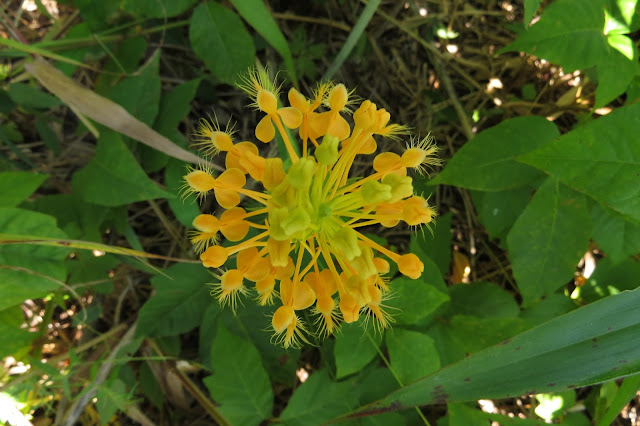Quite a bit of energy is required for a plant to produce a flower. Orchids are able to store energy in underground structures until they have enough energy and conditions are just right for blooming. Some have flowers every year but many only bloom every few years and instead only produce leaves, or have no above-ground presence at all. This is especially true for those species that grow in deep shade.
Here are the strap-like leaves of the Tubercled Rein Orchid (Platanthera flava), part of a large population at a nature preserve in western Ohio.
There were hundreds of plants and not a single bloom all summer! Friends reported that last year was a great year to see this population in bloom, so it is probably not surprising that this year was an "energy storage" year. We were able to see its green flower stalks in bloom in West Virginia, though:
Another similar story was our experience with the Pad Leaf Orchid (Platanthera orbiculata). Its two large round leaves are unmistakeable, and we saw plenty of them on a foray to northern Ohio, but once again we couldn't find any that had flower stalks. We saw several, though on our early July trip to West Virginia, and despite their greenish color we thought they were spectacular.
Here is a closer photo--individual flowers look like flying angels!
We had much better luck in Ohio on lots of others though, and some were really stunning. In July we visited a very wet area in the southeastern part of the state that had all sorts of interesting plants, including the Purple Fringeless Orchid (Platanthera peramoena). Here is a photo of its habitat and you can see how wet it was.
This plant likes lots of water, and we saw several in bloom in a roadside ditch as well as in a more natural wetland. The size of the flower stalks varied quite a bit, and here is one of the largest:
One of my favorites is also a wetland specialist and we saw it in a nature preserve near Springfield. It is the Prairie Fringed Orchid (Platanthera leucophae), and it is considered to be threatened by the U.S. Fish and Wildlife Service.
Habitat loss is the main reason that its status is tenuous; collection of the plants and use of pesticides which kill the hawkmoths that pollinate it are other threats. What a shame it would be if this plant did not continue to do well here in Ohio and across its range.
Here is a tiny orchid that grows in the wet forest or other wet areas and is quite easily missed by the casual hiker. It is called the Club Spur or Green Woodland Orchid (Platanthera clavellata) Interestingly, it is self-pollinating, but insects do visit the flowers. It is relatively uncommon in Ohio but it does occur at Cedar Bog.
Next is arguably the most common orchid in our state: the Downy Rattlesnake Plantain (Goodyera pubescens). One of the easiest to identify, it has evergreen basal leaves that have a beautiful net-like pattern:
Here is a closer look at the lovely but tiny flowers.
It is commonly found in forested areas with acid soils.
Last but not least (for this post anyway) is the gorgeous but tiny Three Birds Orchid (Triphora trianthophora). Its name reflects the plant's tendency to have a trio of blooms:
This orchid blooms in mid-August, when most wildflower activity is in sunny prairies and meadows. It favors mature beech-maple forests, and it doesn't bloom every year in this deep shade. Often it has no above-ground growth, but is still living underground as tuberoids. Populations bloom synchronously, that is all individuals bloom at about the same time, with each flower lasting just about a day. Some flowers have a distinct pinkish tinge:
We saw a lovely population of these orchids at one of the local metro parks, and we were joined by an Ohio State botany professor who is quite interested in this species. He said that it is likely that the plant is "on its way" to heterotrophy--that is, to depending on outside sources such as fungi for energy. It can live for years underground with no sun exposure at all, and when it does come up it just has a very tiny leaf. Photosynthesis probably cannot account for all of its energy input. I'm not sure what advantage this is to the plant, but I sure find evolutionary biology to be fascinating!
That is enough for now--and I still haven't shown you the ladies' tresses! More about those orchids in a future post.
































